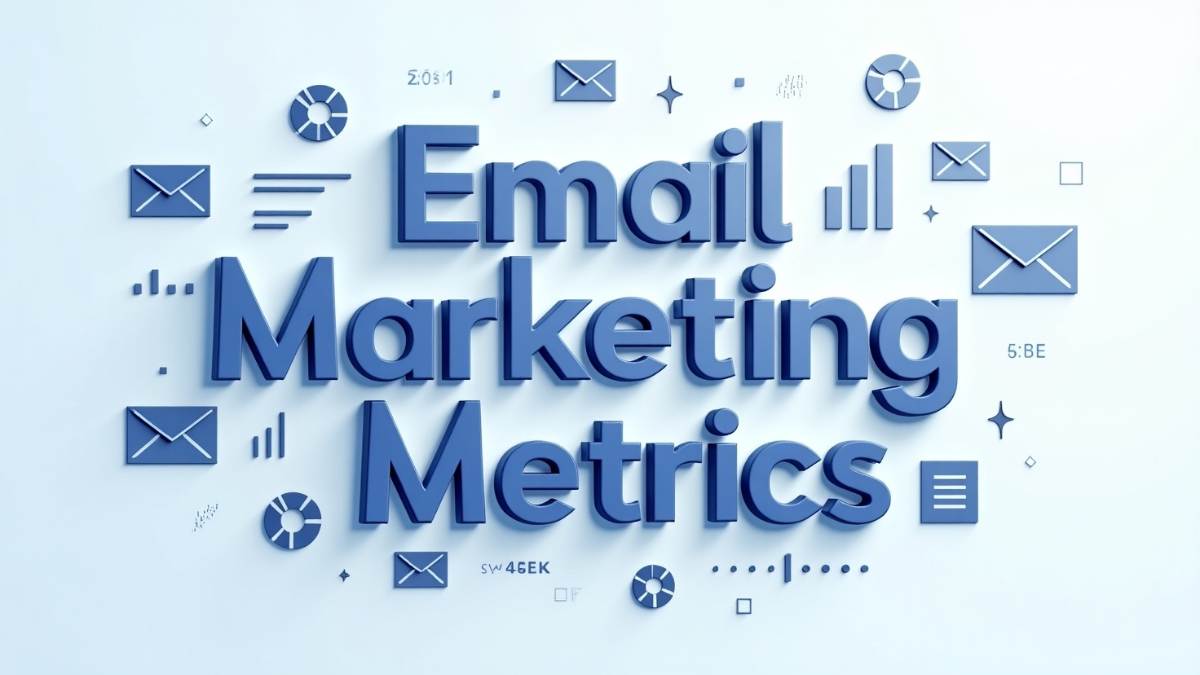If you’re running email marketing campaigns in 2025 and you’re not tracking your metrics properly, you’re basically driving blindfolded.
The inbox has become a noisy place. And with privacy updates, smarter spam filters, and more competition than ever, it’s no longer enough to just send emails. You need to measure how those emails are performing to refine your strategy and maximize your ROI.
That’s what this guide is about.
We’ll break down the essential Email Marketing Metrics you need to know, how to track them, and, most importantly, how to use them to get better results.
Table of Contents
What Are Email Marketing Metrics?
Simply put, email marketing metrics are the numbers that tell you how your email campaigns are performing. Think of them as the health indicators for your email strategy.
Metrics vs KPIs: What’s the Difference?
- Metrics are the raw numbers: open rates, click rates, bounces, unsubscribes.
- KPIs (Key Performance Indicators) are the important metrics you choose to focus on based on your goals.
Example: If your goal is to generate sales from emails, conversion rate would be a KPI. Meanwhile, open rate is a supporting metric.
Why They Matter for ROI-Driven Campaigns
Without tracking, you’re just guessing. Metrics help you:
- See what’s working
- Spot what’s broken
- Optimize for more clicks, more sales, and better engagement
Also Read: Email Newsletter Format
How to Track These Email KPIs Effectively
Knowing what to track is one thing. But how do you actually track these numbers properly?
Let’s keep this super simple:
1. Using Email Platforms (Mailchimp, Klaviyo, Brevo, etc.)
Most good email marketing platforms come with built-in reports. These tools help you easily track things like:
- Open Rate
- Click Rate
- Bounce Rate
- Unsubscribes
- Revenue (in some tools)
Examples:
- Mailchimp → Great for beginners, nice visual reports
- Klaviyo → Awesome for online stores (connects with Shopify/WooCommerce)
- Brevo → Good free plan, helpful reports for small businesses
These platforms usually show you charts and tables so you can quickly spot which emails performed well and which ones flopped.
Pro Tip:
Don’t just look at numbers, compare different types of emails like newsletters, promotional offers, and automated sequences.
2. Leveraging Google Analytics & UTM Parameters
Your email tool tracks opens and clicks, but Google Analytics (GA4) helps you track what happens after someone clicks your email.
Here’s how to connect the dots:
- Add UTM Parameters to your email links (most email platforms do this automatically).
- Example:
https://yourwebsite.com/?utm_source=email&utm_medium=campaign&utm_campaign=summer_sale
- Example:
- Track in GA4:
- See how many people from your email clicked around your site.
- Track sales, sign-ups, or downloads coming from that email.
- See how many people from your email clicked around your site.
Why bother?
This shows you if your email is really bringing business, not just clicks.
3. Setting Realistic Benchmarks & Improving Over Time
Don’t compare your open rate to random numbers on the internet. Set goals based on:
- Your own past performance
- Your industry average
Example benchmarks (as of 2025):
| Metric | Average Range |
| Open Rate | 30–40% |
| Click Rate | 2.5–4.5% |
| Conversion Rate | 1–3% |
| Bounce Rate | <2% |
| Unsubscribe Rate | <0.5% |
The goal:
Try to improve a little every month. If your open rate is 20%, aim for 25% next month by testing better subject lines.
Also read: Top AI Email Writers
How to Use Metrics to Improve Campaigns
Tracking numbers is good, but using those numbers to make your emails better? That’s where the magic happens.
Here’s exactly how to do that:
1. Conducting A/B Tests for Subject Lines, CTAs, and Content
A/B Testing (also called split testing) is when you send two different versions of an email to see which works better.
What you can test:
- Subject lines (short vs. long, emojis vs. plain)
- CTA buttons (“Buy Now” vs. “See More”)
- Images vs. no images
- Different offers (20% off vs. ₹500 off)
Why it matters:
Small changes can sometimes make a huge difference in clicks and conversions.
Pro Tip:
Test one thing at a time so you know exactly what caused the change.
Also Read: A/B Testing vs Multivariate Testing
2. List Segmentation for Better Personalization
Not everyone on your list wants the same thing. That’s where segmentation comes in.
Examples of Segments:
- New subscribers
- Past buyers
- High spenders
- People who haven’t clicked in 3 months
When you send more personalized emails to each group, your open rates, clicks, and sales usually go up.
Example:
Send a loyalty discount to your top buyers. Send a welcome offer to new subscribers. Easy.
3. Tactics to Improve Open & Click Rates
Want better open rates?
- Write curious or benefit-driven subject lines.
- Personalize it with their first name when it makes sense.
- Test different sending times (morning vs. afternoon).
Want more clicks?
- Use clear, bold CTA buttons.
- Keep your content short and easy to skim.
- Tell them why they should click.
4. Ways to Reduce Unsubscribe and Bounce Rates
High unsubscribe rates? Maybe you’re sending too many emails, or the content isn’t what people expected.
Here’s how to fix it:
- Set clear expectations at sign-up (e.g., “1 email per week”).
- Give people choices (“Want fewer emails? Change your preferences.”).
- Make content useful, not just sales pitches.
To reduce bounces:
- Use double opt-in when people sign up.
- Clean inactive or fake emails regularly.
- Avoid buying email lists (it’s spammy and doesn’t work).
5. Maximizing Conversions and Revenue
Clicks are nice, but conversions pay the bills.
Here’s what helps:
- Make sure your email offer matches your website landing page.
- Use urgency (e.g., “Offer ends in 24 hours”).
- Add testimonials, reviews, or success stories in the email for social proof.
Bonus Tip:
Send reminder emails, many people don’t buy on the first click, but might later.
Also Read: Advantages and Disadvantages of Email Marketing
Best Tools for Tracking Email Metrics
Having the right tools makes your life so much easier. The good news? You don’t need a dozen apps, just a few solid ones can handle most of your tracking needs.
Here are some of the best tools to help you keep track of your email marketing metrics:
1. Mailchimp
Best for: Beginners, small businesses, creators
Why it’s good:
- Clean and easy-to-use dashboard
- Tracks opens, clicks, unsubscribes, and more
- Offers A/B testing (even on free plans)
- Basic automation for welcome emails, follow-ups, etc.
Bonus:
Great if you just want to start fast without getting overwhelmed.
2. Klaviyo
Best for: E-commerce stores (Shopify, WooCommerce)
Why it’s good:
- Tracks revenue per email, super helpful if you sell products online
- Shows exactly which emails make you the most money
- Amazing segmentation and automation
- Predictive analytics for better targeting
Bonus:
Integrates deeply with Shopify. Want to see how much ₹ you made from that one email? Klaviyo shows you.
3. ActiveCampaign
Best for: Service businesses, agencies, advanced users
Why it’s good:
- Advanced automation workflows
- Lead scoring and CRM features
- Deep segmentation for different audience groups
- Reports on engagement over time
Bonus:
If you love detailed workflows and advanced targeting, ActiveCampaign is your friend.
4. ConvertKit
Best for: Creators, bloggers, solopreneurs
Why it’s good:
- Super simple interface
- Great tagging system for subscribers
- Easy automation
- Clean reports on open rates, clicks, etc.
Bonus:
Loved by content creators, newsletter writers, and educators.
5. Google Analytics (GA4)
Best for: Tracking behavior after someone clicks your email
Why it’s good:
- Tracks how many email visitors go on to buy, sign up, or explore your site
- Shows bounce rates on landing pages
- Works perfectly with UTM parameters
Bonus:
Pair your email campaigns with GA4 to see the full customer journey.

Enroll Now: Advanced Digital Marketing Course
6. Litmus
Best for: Testing how your emails look across different devices and inboxes
Why it’s good:
- Preview emails in Gmail, Outlook, Apple Mail, etc.
- Test load speed and mobile responsiveness
- Spam filter testing
Bonus:
If you send polished, brand-heavy emails and want them to look perfect, Litmus is the one.
Do you need all these tools?
No.
Here’s a quick guide to help you:
| Goal | Best Tool |
| Start quickly, basic emails | Mailchimp |
| Sell products online | Klaviyo |
| Advanced automation | ActiveCampaign |
| Creator newsletters | ConvertKit |
| Deep website tracking | Google Analytics (GA4) |
| Perfect email previews | Litmus |
Conclusion
Email marketing in 2025 isn’t about luck, it’s about numbers. Tracking your email metrics gives you the map to better results. When you know what’s working (and what’s not), you can test, improve, and grow your revenue steadily.
Don’t try to chase every metric at once. Start with the basics: open rates, clicks, conversions. Then move into advanced tracking as you grow. Remember, small improvements each month add up to big wins over time.
If you’re serious about growing with email, focus on building a healthy list, sending valuable content, and learning from your numbers. That’s how you win with email marketing today.
FAQs: Email Marketing Metrics
1. What’s the difference between CTR and CTOR?
CTR shows clicks from all delivered emails. CTOR shows clicks from people who opened your email. CTOR helps you judge how good your email content is.
Which is more important: open rate or click rate?
Click rate is more important. Opens can be misleading due to privacy settings. If people click, they’re clearly interested in what you’re offering.
What’s a good email conversion rate for 2025?
A conversion rate of 1% to 3% is generally solid. Focus more on improving your own rates over time rather than comparing to others.
How do I fix a high bounce rate in my emails?
Remove invalid emails, use double opt-in, and regularly clean your list. Also, check if your domain reputation is causing delivery issues.
How often should I review my email metrics
Check after every email campaign. Do a full review monthly to spot trends and areas for improvement. Regular checks = steady growth.
Do inactive subscribers harm my deliverability?
Yes. Too many inactive subscribers lower engagement rates, which affects inbox placement. Regularly clean or re-engage these contacts to maintain good deliverability.

